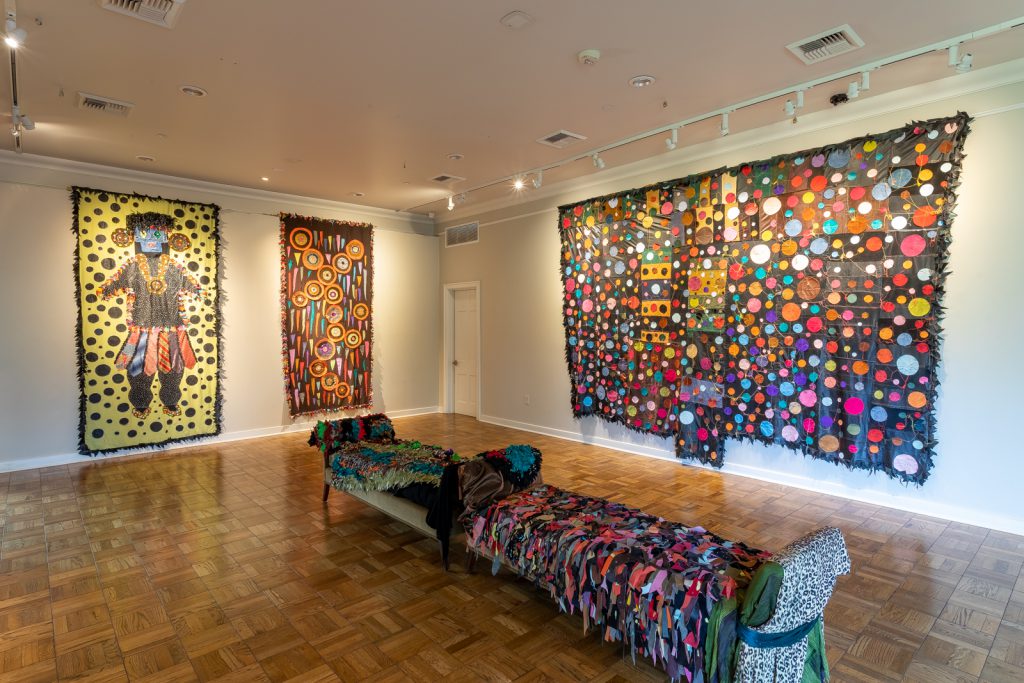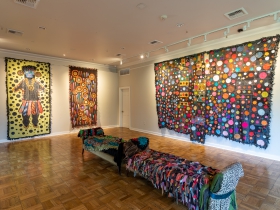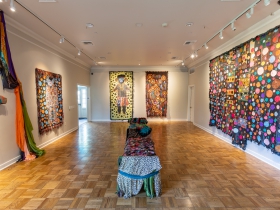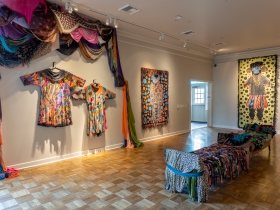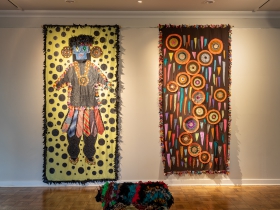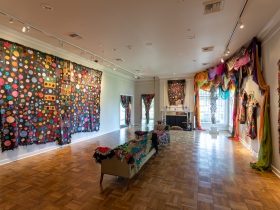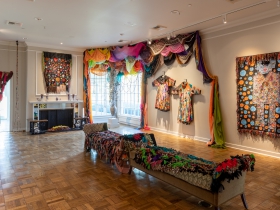Patterns of a Life
Viewers are immersed in the work of artist Rosemary Ollison, 77, which overflows the Lynden space.
The nature of Rosemary Ollison’s work invites us to enter into her world. In her current solo exhibition, “Prosperity in a Million Scraps,” at The Lynden Sculpture Garden, viewers are immersed in the textures, patterns and colored materials of her wall hangings, sculptures and drawings. The work wants to be seen as an environment because it was born out of an environment.
Similar to the home of the late artist Mary Nohl, almost every inch of Ollison’s apartment/work space is covered with her work, from quilts and rugs to curtains of woven leather. Ollison’s artistic practice started in the early 90’s when, in the depths of despair, she was inspired by the story of Jesus and the Canaanite woman who asked for the healing of her daughter and was granted this miracle because of her faith (Matthew 15:21-28). Ollison prayed to God, promising that if he could reclaim her life, she would build a world from scraps. Her spirit was healed, she says, and she began to play with repurposed materials such as glass, leather and beads. She started creating work with religious zeal and her work has flowed ever since. The 77-year-old artist is represented by Portrait Society Gallery and was recently awarded the 2018 Nohl Fellowship in the Emerging Artist Category and was named 2019 Artist of the Year by the Milwaukee Arts Board.
The huge quilts that hang in this exhibition were not seen by the artist in their entirety until they were installed because her apartment is not large enough to fully spread them out. Not only does the work consume the gallery, it overflows into the hall and dining room and adorns the table.
As I turned to re-enter the main gallery space, I saw Polly Morris, director of The Lynden, and we chatted about the show. She said Rosemary refused to be there (as with all of her shows) when the work was hung. I was surprised and pointed at the cascades of colorful fabric attached to the ceiling, glowing with afternoon light. “I did that along with Bruce Knackert, our collections manager,” Polly said with a bemused smile. After seeing her reaction to this memory, I realized perhaps one reason why Ollison doesn’t participate in the installation process is that her absence allows the installers freedom to play with the work.
The collaboration is evident in the spirit of this exhibition. Unlike a painting or sculpture which arrives in bubble wrap or crates, this work arrives to the gallery in bags. Quilts and textiles must be handled and held close, played with and adjusted. Polly motions towards two entrances and explains that choreographer Reggie Wilson, a participant in the Lynden’s Call and Response programming, created braided fabric pieces in response to Ollison’s hangings. The ability of her work to inspire others to create is natural.
In a piece like “Mamma”, Ollison’s largest leather quilt to date, we see colorful circles of leather cut and placed against a dark background creating a space that feels simultaneously celestial and microscopic. The quilt is pieced together and has a slightly irregular shape. At the bottom center there is a longer piece of leather attached like a stubby tail. The overall shape is reminiscent of an animal skin, a mammoth pelt of colorful and harmonic love. Upon closer inspection, I noticed that the threads remain attached to the quilt and form a delicate web of organic pattern connecting the circles like drips, some gathered and balled in small nests. For Ollison, this is a conscious choice, a way of demonstrating that all things not made by God have flaws. I’m grateful for this because in the flaws there lies great beauty.
It’s a unique show. “Prosperity in a Million Scraps” runs through December 8 a the Lynden Sculpture Garden, 2145 W. Brown Deer Rd.
“Prosperity in a Million Scraps” Gallery
If you think stories like this are important, become a member of Urban Milwaukee and help support real independent journalism. Plus you get some cool added benefits, all detailed here.
Art
-
Winning Artists Works on Display
 May 30th, 2024 by Annie Raab
May 30th, 2024 by Annie Raab
-
5 Huge Rainbow Arcs Coming To Downtown
 Apr 29th, 2024 by Jeramey Jannene
Apr 29th, 2024 by Jeramey Jannene
-
Exhibit Tells Story of Vietnam War Resistors in the Military
 Mar 29th, 2024 by Bill Christofferson
Mar 29th, 2024 by Bill Christofferson
Review
-
Ouzo Café Is Classic Greek Fare
 May 23rd, 2024 by Cari Taylor-Carlson
May 23rd, 2024 by Cari Taylor-Carlson
-
‘The Treasurer’ a Darkly Funny Family Play
 Apr 29th, 2024 by Dominique Paul Noth
Apr 29th, 2024 by Dominique Paul Noth
-
Anmol Is All About the Spices
 Apr 28th, 2024 by Cari Taylor-Carlson
Apr 28th, 2024 by Cari Taylor-Carlson



